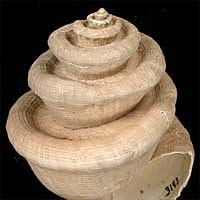|
< Previous family introduction |
|
|||||
 |
Family
Buccinidae
Buccinid whelks |
|||||
|
This subfamily contains some of the largest gastropods, reaching up to 260 mm in length, along with smaller species that do not exceed 30 mm. There is a corresponding variation in form, with the larger whelks being relatively light in weigh and spindle-shaped with a long canal, while the smaller species are stouter with a short canal. Sculpture is variable throughout the family, with strong axial folds and strong spiral ribs both occurring; varices are absent or poorly defined in some groups, or strong in genera such as Colubraria. There is a thin corneous operculum with the nucleus apical or near the margin. The family is world-wide in distribution, with the larger species occurring subtidally in both northern and southern temperate and cold seas. In the northern hemisphere, Buccinum undatum is the predominant species in shallow coastal waters of the North Atlantic, with Neptunea occurring northwards into Arctic seas. In southern temperate seas the large whelks of the genus Penion occur in an equivalent situation. The smaller species of the tropics are more common intertidally, with only a few deep water representatives. Buccinids are carnivorous, some being predators on other molluscs and some being scavengers. The specific prey of the Australian species is not reported in the literature, but the diet of the North Atlantic species Buccinum undatum has been reported in detail. It feeds on polychaete worms, bivalves and sea urchins, particularly by feeding on the remains of bivalves killed by seastars. There is no consensus on the extent of the family Buccinidae. Some authors regard the family as including the subfamilies Buccininae, Pisaniinae, Fasciolariinae and Nassariinae. Each of these has traditionally been treated as a seperate family, but Ponder & Warén (1988) reduce them to subfamilies "because there are virtually no known characters that consistently and reliably separate them at family level". In this work, the more traditional approach is adopted of leaving Buccininae and Pisaniinae as subfamilies in the Buccinidae, with Fasciolariidae and Nassariidae as separate families. Since the monographs of the last century, the Buccinidae has not been revised on a worldwide level, although several revisions at regional level have been published. In the Australian region, the work of Ponder (1972, 1973) has revised the genus Penion and clarified the genus Engina, but as Ponder reports, the shells, radula and opercula have few characters that allow for clear-cut taxonomic divisions. Consequently, future modification to the generic placements given here are to be expected. Of the subfamily Buccininae, most of the species found in NSW are of sublittoral habitat with a southern Australian distribution; some occur in the shallow subtidal, the large whelks are common on the continental shelf, and others, such as Kapala kengrahami, are restricted to the continental slope. Only Cominella lineolata is common intertidally, but restricted to the south of the state. The two Phos species are of Indo-West Pacific distribution, and are more common in the north of the state. Of the subfamily Pisaniinae, none of the species are common in NSW. The Colubraria species live subtidally, and are only occasionally encountered as beach shells. The Fusus species occur on the continental shelf, and are rare in collections, although they appear to be reasonably common in their habitat. Most of the species of Engina are tropical in distribution, only occurring rarely in northern NSW, the exception being Engina australis which is moderately common on rocky shores in eastern and southern Australia.
Family References
All species of Buccinidae known to occur in NSW are treated here. In addition to those figured, the following are recorded from the state.
Cantharus pulcher Cantharus iostomus Engina armillata Engina curtisiana Engina egregia Engina incarnata Engina lineata Engina zonalis Fusus bednalli Fusus reticulatus Pisania fasciculata |